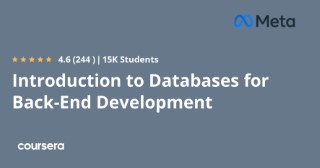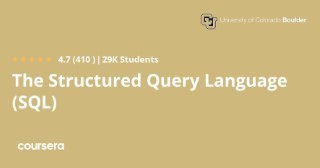Introduction to Databases for Back-End Development
Learn the basics of databases and gain experience with SQL commands. Explore different types of database management systems and design a relational database system. Gain fundamental knowledge in database concepts and MySQL syntax. Enhance your career as a database engineer.
Back-end developers write applications that end-users use to interact with databases. Some common tasks that end-users carry out using these applications include storing, searching, extracting and manipulating data.
Therefore, it’s essential that all back-end developers possess strong knowledge and experience with how databases work.
In this course, you’ll receive an introduction to databases and explore the different ways in which they can be used to store and manage data. You’ll also learn to distinguish between different types of database management systems. You’ll then practice basic creation and data selection tasks with the use of Structured Query Language (SQL) commands.
By the end of this course, you’ll be able to:
– Demonstrate a working knowledge of the concepts and principles that underpin how databases work
– Identify and explain the different types of core technology and management systems used in
databases
– Identify and interpret basic SQL statements and commands
– Manipulate records in a database with the use of SQL statements and commands
– Outline alternatives to SQL
– and plan and design a simple relational database system
You’ll also gain experience with the following:
– Fundamental concepts in database
– Basic MySQL syntax and commands
– Database management systems
– Relational databases
What you will learn
Introduction to Databases
In this module, you’ll receive an introduction to the course and explore possible career roles that you could follow as a database engineer. You’ll also review some tips on how to take this course successfully and discuss what it is that you hope to learn. As part of your introduction, you’ll learn about the basics of databases and data and how they work. You’ll then receive an introduction to SQL, or Standard Query Language, the coding syntax used to interact with databases. Finally, you’ll explore the basic structure of databases and discover the different types of keys they use.
Create, Read, Update and Delete (CRUD) Operations
In this module, you’ll explore CRUD, or Create, Read Update and Delete operations. You’ll begin with an exploration of SQL data types and learn how to differentiate between numeric data, string data and default values. You’ll also embark upon several exercises in which you’ll learn how to utilize these different data types within your database projects. You’ll then move on to learn how to Create and Read data within a database. You’ll discover how to create databases and tables and populate them with data using SQL statements. Lastly, you’ll explore the SQL statements used for updating and deleting data in a database. And to demonstrate your ability with CRUD operations, you’ll complete exercises that will task you with creating and managing data.
SQL Operators and sorting and filtering data
In this module, you’ll explore SQL operators and learn how to sort and filter data. You’ll begin this module with a lesson on SQL operators. As part of this first lesson, you’ll explore the syntax and process steps used to deploy SQL arithmetic and comparison operators within a database. Next, you’ll discover how to sort and filter data using clauses. The clauses that you’ll learn about include the Order By clause, Where clause and Select Distinct clause. In each lesson item, you’ll receive an overview of how each clause is used to sort and filter data in a database. You’ll also view demonstrations of these clauses and then receive an opportunity to try them for yourself.
Database design
In this module, you’ll learn about database design. In the first lesson, you’ll receive an overview of how to design a database schema. As part of this overview, you’ll learn about basic database design concepts like schema and find out about different types of schemas. The next lesson focuses on relational database design. In this lesson, you’ll explore how to establish relationships between tables in a database using keys. You’ll also learn about the different types of keys that are used in relational database design, such as primary keys and foreign keys.
User Reviews
Be the first to review “Introduction to Databases for Back-End Development”
You must be logged in to post a review.







There are no reviews yet.